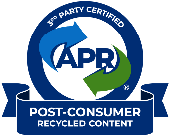Our process uses an innovative recycling technology.
The game-changing polypropylene recycling technology that PureCycle uses is a form of dissolution. It consists of six main process stages that help close the loop on plastic waste while making recycled plastics more accessible at scale.
The process incorporates units of operation that have been in existence for decades, and extraction and filtration are at the heart of the process. These two simple concepts allow us to produce an industry-first, ultra-pure recycled plastic.
Melting and Filtering
Our process begins with feedstock made up of reclaimed consumer packaging and many other discarded products traditionally destined for a landfill, such as fiber found in carpet, the film found in food packaging and liners, and flake found in stadium and event trash. The polypropylene recycling process begins when polypropylene plastic feedstocks are melted down in the polymer extruder.
The polymer then moves to the polymer filter, where large contaminants and large non-melt materials are filtered out of the feedstock.
Polymer Extraction Column
Upon being melted down, the contaminated plastic is put into the solution at unique conditions that start the purification process.
During extraction, our process creates the ideal conditions where dissimilar things separate. Like hot water can extract tannins from tea leaves, fresh solvent pulls out color and odor from the solution during extraction. The light stream is a byproduct stream, co-product 1, that is collected later in the process.
Polymer Mixer and Large Particle Settler
The polyethylene/solids settler allows contaminations and other plastics, also known as insoluble solids and polymers, to settle out of the process.
These large particulates form a byproduct stream, co-product 2, that is collected later in the process.
Columns
The polypropylene solution is further polished through contact with a solid, media-packed column.
This particular step purifies the product by removing color, tiny particles of contamination, and other contaminants based on their physical and chemical properties.
Polypropylene/Solvent and Product Decanter
The purified polypropylene is separated from the solvent in the product decanter.
The solvent is recovered and reused in the process, eliminating solvent waste.
Polymer Extruder and Polymer Pelletizer
From there, the polypropylene feeds into the final product extruder. We then add back in the additives that the process removed during the final extrusion.
During the final production stage, the polymer is cut into pellets and dried. The final product is ready to be evaluated by quality control, closing the loop on polypropylene waste. Now our polymer is ready for your product, which can then be recycled multiple times.



